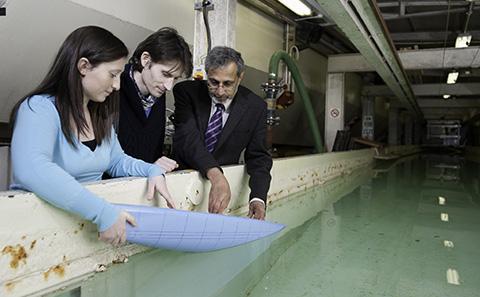Transforming shipping across the world
Improving efficiency and productivity
It is a multi-million euro project that is set to transform shipping across the globe and one that researchers at the University of Southampton are at the heart of.
With a history intrinsically linked to seafaring, any efforts to improve the efficiency and productivity of maritime trading and travel is likely to have a direct impact on the economic success of the UK as a whole.
Combine that with a system that could see huge strides made towards cutting pollution levels, and the importance of the Sea Traffic Management (STM) project begins to resonate. Half of the €43m project is funded by the EU alongside support from partners across the shipping sector.
The aim is to deliver a real-time information sharing system, which will result in more efficient port operations and reduced cost and delay for shipping companies. By sharing information including route plans, berth slots, weather forecasts and safety warnings the hope is that it will lead to a more efficient industry.
Currently, vital time and money is being lost when ships are left stacked in a queue waiting for an available berth at busy times. While waiting, the ships are emitting environmentally-damaging pollutants and revenue is potentially being lost as the cargo is delayed reaching its destination.
Conversely there are times when port operations stand idle while waiting for ships to arrive. The purpose of STM is to ensure that there is a regular flow of sea traffic with arrival times being coordinated through the sharing of travel routes.
Ships can be advised to slow down or speed up to make a particular slot or be rerouted to avoid adverse weather conditions that could slow them down.
According to findings of an earlier project from which the STM originated, the reduced waiting times and better route planning could lead to a 10 to 15 per cent reduction in greenhouse gases. It is also hoped that the system could lead to a reduction in collisions, as officers would have more information at their disposal when navigating busy waterways.
The overall benefit will reflect in a reduced environmental footprint for the transport chain and navigational practice reducing the risk of close-quarter incidents
Putting the theory into legally-sound practice
The project is now being validated at both test-bed and real-life level with some 130 ships already trialling the on-board console systems.
Researchers from the University are involved in examining the legalities surrounding the visibility of the shared information to the various stakeholders. Leading the task on legal feasibility is Mikis Tsimplis, Professor of Oceanography and Maritime Law. He explained how maritime law is being examined to see whether it is compatible with the regulatory system in place and the existing business model. And whether changes in laws and contracts and behaviour need to be addressed.
“We lead on the area of legal feasibility in relation to applicable shipping regulations, for example testing whether the changes in the ship’s bridge and the behavioural changes that follow are consistent with the shipping laws and practices as they apply today,” he says.
Mikis explained how they were also examining concerns raised over the potential safety impact of the new system. “We are looking at whether training would need to be stipulated for what to do in certain circumstances where, for example, the crew was receiving information from the STM console, regarding a declared ship route for another vessel, but seeing something develop in front of them, which was quite different.”
The new system would also have to address cyber security and the rules governing the use, sharing and responsibility of information, particularly as the ships will inevitably move between international jurisdictions.
Subject to successful trials it is estimated that the new system could be implemented by 2030 after which time, shipping companies particularly cargo and passenger firms, are anticipated to adopt the new system.
Mikis added: “The transportation chain including ships and ports needs to become more efficient. The thinking is, if ports endorse the system and ship owners view it as an efficiency saving it will drive the competition so that many more ports and shipping companies will also sign up to it.
“The overall benefit will reflect in a reduced environmental footprint for the transport chain and navigational practice reducing the risk of close-quarter incidents.”
The University of Southampton team is interdisciplinary and reflects collaboration between the Institute of Maritime Law and the Southampton Marine and Maritime Institute. Professors Ajit Shenoi and Filippo Lorenzon; Drs Meixian Song and Sophie Stalla-Bourdillon; and Spiros Papadas and Evangelia Papadaki, are all part of the Southampton team.
Image credit: STM
Watch how the Sea Traffic Management could change the shipping industry, with the help of Southampton academics:
More about Mikis' research
You may also be interested in:

Future-proofing our oceans
Conserving ocean spaces and developing the ships and naval vessels of the future

Creating a sea change
Informing policy on the conservation of coral reefs

Next stop, the future
Southampton research is providing evidence-based solutions for improving rail networks